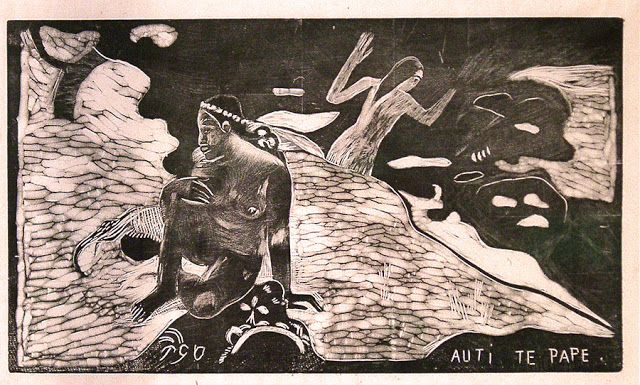Tom Huck: Not your average woodcut.
The woodcut is one of the oldest printmaking techniques, mirroring the development of paper itself in second century China.
In western art the woodcut evolved from the utilitarian
printing of textiles with wood blocks in the early 14th century. Although paper was being imported to Spain by the 11th century, it was not
until Europe began producing large quantities in
the 14th century that the artistic development of the woodcut began to unfold.
As movable type came into use in the mid-15th
century, woodcuts became highly developed for the illustration of various religious books. By the late 15th century many of the great artists including Dürer, Hans Holbein and
Titian were using the medium.
 |
| “Rhinocerus”, woodcut, Albrecht Dürer 1515 |
After the mid-16th century the use of woodcut began to decline in favor of the detail and flexibility of line engraving
and etching: instead it became an economical means for book, magazine, and newspaper illustrations.
It was not until the late 19th century that it regained its place as a major expressive form in the prints of Gauguin, the German Expressionists and the Norwegian
expressionist Edvard Munch.
 |
| “Auti Te Pape” (Women at the River), woodcut, Paul Gaugin 1891 |
Fast forward a century: the digital revolution is in full swing, and printmaking is a process dominated by enormous computerized machines dealing with pixels and synthetic inks. Today’s printer is hardly likely to use a pencil, much less traditional woodcarving tools. Yet just out of downtown St. Louis, Missouri a large, heavily tattooed, reportedly dangerous man is determinedly taking those tools in hand to unleash his own particular brand of dementia .
 |
| “The Transformation of Brandy Baghead”, woodcut on paper: Tom Huck 2009 |
Tom Huck was born on December 9, 1971 in Farmington, Missouri and grew up in nearby Potosi- a town of roughly 2,600 god fearing souls located about 70 miles southwest of St. Louis. He apparently didn’t fit in. Speaking in front of a group at his old High School in 2007 he offered these words of advice:
“I am asked regularly about why I do what I do and why it is so
satirical in its nature. I tell them it is all about one word:
revenge… you will be doubted by a lot of people. The doubters from all
areas
of your life can be of great inspiration to you — especially from your
high school years. Making your doubters eat crow is the sweetest revenge
of all.”
Huck went on to attend Southern
Illinois University in Carbondale where he earned his Bachelor of Fine
Arts in Drawing, then a Master of Fine Arts in Printmaking from
Washington University in St. Louis in 1995. Since 1995 he has
exhibited on a national and international level; his prints are included
in numerous public and private collections, including the Whitney Museum
of American Art, Spencer Museum of Art, Nelson Atkins Museum of Art,
Saint Louis Art Museum, Milwaukee Art Museum, Fogg Art Museum, and New
York Public Library.
 |
| “Highwater Hog Blues”, 2000 |
The prints are produced in limited editions of twelve to fifteen,
priced at about $3,000 apiece — and he usually can’t carve more than one
or two blocks a year. In some cases he begins with a 8’x4′ sheet of birch plywood then carves the mirror image of the print: 4,500-plus square inches scraped and cut with a gouge not much thicker
than a pen. He’ll only know if it “works” after months worth of labor.
 |
| “Commander and Thief Rides Again”, 2008 |
 |
| “Pork Chop Suey”, 2007 |
“…the gruesome accounts of Huck’s worldview are not for the faint of
heart. This exhibition is a bountiful orgy of food, sex, alcohol, and
violence all supporting Huck’s larger narratives of Americana: racism,
warfare, greed, gluttony and injustice.” (Happenstand)
On April 1, 2012 Huck released “The Hillbilly Kama Sutra”, fifteen linoleum cuts of his iconic rednecks fondling each other in a landscape that Hieronymous Bosch would find inspirational. “It’s an ode to dirty living. No matter how high-class you think you are, you’re going to do it… no matter how snooty you are, or how hard you try, death is going to find you.” Huck claims his own inspiration was Hans Holbein’s “Dance of Death” (1538). (The full image set is available on his website, Evilprints.com )
 |
| “Bone Rubbin'” |
 |
| “Mile-High Hand Job” |
 |
| “One Nite Only” |
 |
| The Squeexxx |
References:
www.evilprints.com (Tom Huck official site)
Riverfront Times April 12, 2012- Hillbilly Kama Sutra: A new suite of linoleum cut prints by Tom Huck












Comments
Tom Huck: Not your average woodcut. — No Comments
HTML tags allowed in your comment: <a href="" title=""> <abbr title=""> <acronym title=""> <b> <blockquote cite=""> <cite> <code> <del datetime=""> <em> <i> <q cite=""> <s> <strike> <strong>